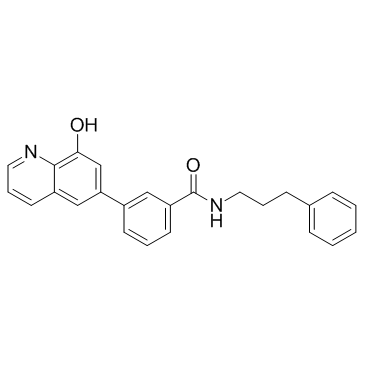| Description |
NCGC00244536 is a potent KDM4B inhibitor with an IC50 of 10 nM.
|
| Related Catalog |
|
| Target |
IC50: 10 nM (KDM4B)[1]
|
| In Vitro |
NCGC00244536 displays high selectivity for the fast-growing AR-negative PC3 cells (IC50=40 nM) and over 100-fold selectivity against the immortalized prostate epithelial cell lines PrEC1 and PrEC4. NCGC00244536 effectively inhibits AR-positive cell lines, including LNCaP and VCaP, with IC50s in the sub-micromolar range, and abolishes androgen-stimulated LNCaP cell growth. NCGC00244536 is also potent in inhibiting the growth of other cancer cell lines, including the breast cancer cell lines MDA-MB2 and MCF-7, with micromolar IC50s[1].
|
| In Vivo |
Treatment with NCGC00244536 results in significant inhibition of tumor growth and animals do not exhibit any major toxicity and appear to be normal. Histological data clearly indicate that NCGC00244536-treated tumors have significant amount of cell apoptosis, necrosis, and fibrosis[1].
|
| Cell Assay |
LNCaP cells are treated with 0.1, 0.2, 1, 2.5, 5, 20 μM of NCGC00244536. Cell viability is measured using the MTT assay[1].
|
| Animal Admin |
Mouse: For xenograft animal model, PC3 cell suspension is injected into 4-6 weeks old severe combined immunodeficient (SCID) mice. When tumors become palpable, animals are randomly grouped for drug treatment. Alzet osmotic minipump containing NCGC00244536 (20 mg/kg)is subcutaneously inserted into each animal, which allowed continuous drug delivery to the tumor site for up to 5 days. Tumor volume is recorded every other days and calculated by using the ellipsoid formula[1].
|
| References |
[1]. Duan L, et al. KDM4/JMJD2 Histone Demethylase Inhibitors Block Prostate Tumor Growth by Suppressing the Expression of AR and BMYB-Regulated Genes. Chem Biol. 2015 Sep 17;22(9):1185-96.
|
